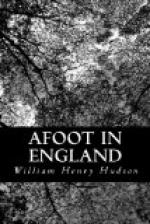Arrived at Three Mile Cross, it was no surprise to find it no longer recognizable as the hamlet described in Our Village, but it was saddening to look at the cottage in which Mary Russell Mitford lived and was on the whole very happy with her flowers and work for thirty years of her life, in its present degraded state. It has a sign now and calls itself the “Mitford Arms” and a “Temperance Hotel,” and we were told that you could get tea and bread and butter there but nothing else. The cottage has been much altered since Miss Mitford’s time, and the open space once occupied by the beloved garden is now filled with buildings, including a corrugated-iron dissenting chapel.
From Three Mile Cross we walked on to Swallowfield, still by those never-ending roadside red-brick cottages and villas, for we were not yet properly out of the hated biscuit metropolis. It was a big village with the houses scattered far and wide over several square miles of country, but just where the church stands it is shady and pleasant. The pretty church yard too is very deeply shaded and occupies a small hill with the Loddon flowing partly round it, then taking its swift way through the village. Miss Mitford’s monument is a plain, almost an ugly, granite cross, standing close to the wall, shaded by yew, elm, and beech trees, and one is grateful to think that if she never had her reward when living she has found at any rate a very peaceful resting-place.
The sexton was there and told us that he was but ten years old when Miss Mitford died, but that he remembered her well and she was a very pleasant little woman. Others in the place who remembered her said the same—that she was very pleasant and sweet. We know that she was sweet and charming, but unfortunately the portraits we have of her do not give that impression. They represent her as a fat common-place looking person, a little vulgar perhaps. I fancy the artists were bunglers. I possess a copy of a very small pencil sketch made of her face by a dear old lady friend of mine, now dead, about the year 1851 or 2. My friend had a gift for portraiture in a peculiar way. When she saw a face that greatly interested her, in a drawing-room, on a platform, in the street, anywhere, it remained very vividly in her mind and on going home she would sketch it, and some of these sketches of well known persons are wonderfully good. She was staying in the country with a friend who drove with her to Swallowfield to call on Miss Mitford, and on her return to her friend’s house she made the little sketch, and in this tiny portrait I can see the refinement, the sweetness, the animation and charm which she undoubtedly possessed.




